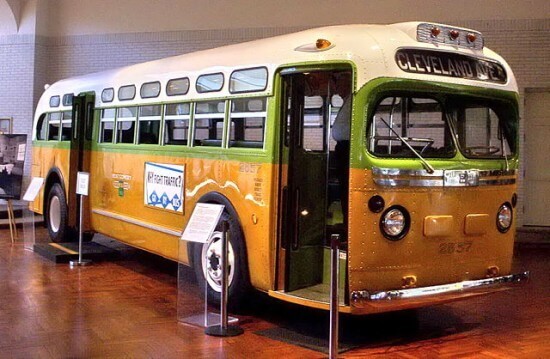
You have probably heard of Rosa Parks. What you may not know is that her arrest was just the start of a year-long event that involved all the busses in the city where she was arrested. The Montgomery bus boycott is an important event in the Civil Rights movement, and should be examined from start to finish.
1. What was it?
The Montgomery Bus Boycott was a boycott of the Montgomery bus system. This means that people were refusing to ride the buses. They were refusing to do so because the buses were segregated. It was part of the Civil Rights movement.
2. What started the boycott?
Rosa Parks started the movement. She, a black passenger, refused to give up her seat to a white passenger. She was subsequently arrested, which sparked the boycott.
3. How long did the boycott last?
The boycott started December 1st 1955, with the arrest of Rosa Parks. It lasted until December 20th, 1956, when the Supreme Court ruling in Browder v. Gayle took effect.
4. Rosa Parks was not the first person arrested
A teenaged girl was arrested for the same reason several months prior to Parks being arrested. However, the teenager was pregnant, and the leaders of the NAACP decided not to draw attention to the situation yet. They wanted someone people would support to be the face of the campaign, so to speak. Rosa Parks was the perfect candidate, and so the movement started with her arrest.
5. Key Players
Of course, Rosa Parks was a key player, as her arrest started the movement. The movement was started by E. D. Nixon, the president of the local NAACP chapter. Martian Luther King Jr. also played an important role, leading the association (MIA) that lead the boycott.
6. Compromise
An early demand in the boycott was not for busses to be desegregated. Rather, King called for a permanent divider line between the white area of the bus and the black area. This would mean if the white area was filled, new passengers that were white would have to stand. Black passengers would no longer have to give up their seats, as long as they sat in their own area.
7. Support
Very few blacks rode the bus the first day of the boycott, and so it continued. Enough riders were lost that the city faced economic hardship. Carpooling started, and some whites even gave blacks rides to work. Black cab drivers charged ten cents for far, the same amount the bus ride would have cost, to encourage people to take cabs. Nationwide, churches collected shoes to replace old shoes worn by those choosing to walk rather than ride the busses.
8. Violence
While the boycott was having much success, there was a price to be paid. Kings house was firebombed. Many who participated in the boycott were physically attacked on the street. Supporters were under constant threat. King was jailed for two weeks for conspiracy to interfere with a business. It was not all smooth sailing.
9. Court case
The civil case related to the boycott, Browder v. Gayle, was first heard in federal district court. The ruling came June 4th, 1956, that segregations on busses is unconstitutional, and therefore illegal. The case was appealed, however, and the boycott continued while the appeal went through. The appeal was heard by the Supreme Court and was ruled on November 13th, 1956. They agreed with the district court, and so the laws segregating the busses were unconstitutional.
10. Success
The boycott came to a close December 20th, 1956, almost 13 months after it had started. The boycott ended when local ordinances made it possible for black passengers to sit anywhere on the bus that they chose. The boycott spotlighted King as a leader in the Civil Rights Movement and sparked many more events in the movement.

Leave a Reply